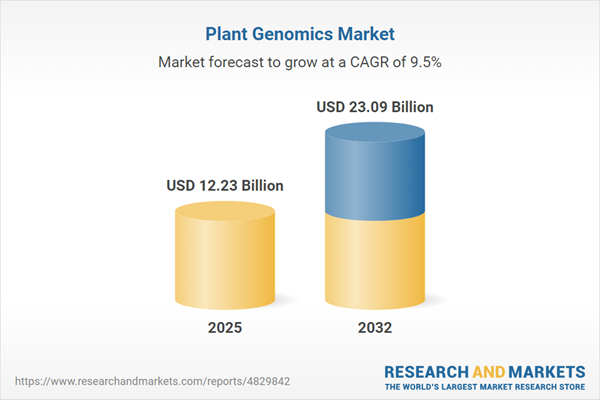Speak directly to the analyst to clarify any post sales queries you may have.
The plant genomics market equips senior executives with strategic solutions for advancing agricultural resilience, operational efficiency, and precise decision-making. As innovation accelerates, leaders are reimagining how genetic technologies drive progress, competitiveness, and adaptability across diverse markets.
Market Snapshot: Plant Genomics Market Overview
The plant genomics market is exhibiting steady expansion, supported by a surge in investment toward genetic technologies and greater automation throughout the sector. This momentum is reshaping R&D strategies, as decision-makers recognize plant genomics as a lever to strengthen competitive positioning and enhance operational agility. Advances like next-generation sequencing and gene editing are expediting both breeding cycles and product development, leading to improved quality control and refined supply chain practices. As the market continues to mature, organizations are adapting to new compliance challenges, underscoring the value of agile and forward-looking leadership in meeting evolving industry demands.
Scope & Segmentation: Actionable Intelligence Across the Plant Genomics Sector
This report delivers targeted market intelligence, supporting informed investment and partnership decisions for leaders navigating the plant genomics sector. It clarifies core market segments and the ecosystem’s diversity across regions and stakeholders:
- Product Types: Includes genomic analysis instruments, reagents, consumables, laboratory services, and data software—each element enabling transformation from lab research to commercial deployment.
- Technologies: Features precision platforms such as CRISPR, zinc finger nucleases, high-throughput sequencers, and advanced PCR tools. These technologies accelerate trait identification and genetic mapping, supporting organizational goals for targeted R&D.
- Service Models: Encompasses consulting, contract research, and analytical testing, offering streamlined project execution and broader access to specialized expertise.
- Applications: Highlights disease resistance, trait modification, genetic disorder diagnostics, prenatal testing, and biomarker identification—addressing both agricultural productivity and wider life sciences initiatives.
- End Users: Represents academic research institutions, commercial agriculture operations, diagnostic laboratories, public health agencies, biotechnology leaders, and pharmaceutical companies—each fostering unique contributions to a collaborative landscape.
- Regions Covered: Encompasses global perspectives from the Americas, Europe, Middle East and Africa, and Asia-Pacific, analyzing the unique growth dynamics found in China, India, and Japan, as well as region-specific compliance trends.
- Companies Featured: Examines strategic leadership from firms such as Illumina, Thermo Fisher Scientific, BGI Genomics, QIAGEN, Agilent Technologies, PerkinElmer, Pacific Biosciences, Oxford Nanopore Technologies, Eurofins Scientific, and Merck KGaA, each demonstrating distinct approaches to market development.
Key Takeaways for Senior Decision-Makers
- Next-generation sequencing and gene editing empower organizations to adapt proactively to evolving agricultural needs and shifting regulatory expectations, supporting rapid response capabilities.
- Artificial intelligence enhances genomics workflows by boosting throughput and optimizing resource allocation across research and production, leading to improved efficiency and more reliable outcomes.
- Forging strong partnerships with both suppliers and regulators strengthens supply chain resilience and safeguards ongoing expansion, particularly when navigating disruptions in global markets.
- Deployment of modular informatics systems and agile operating models addresses the challenges of maintaining competitiveness and regulatory compliance amid changing sector requirements.
- Regional customization of genetic initiatives drives sustainability efforts and supports commercial differentiation, ensuring organizations can meet diverse market needs worldwide.
Tariff Impact: Navigating Regulatory and Supply Chain Disruptions
Ongoing U.S. tariff adjustments have introduced additional procurement challenges for plant genomics materials and platforms. In response, procurement teams prioritize strengthening supplier relationships, increasing local and diversified manufacturing, and building cross-regional partnerships. These risk mitigation strategies address supply chain vulnerabilities, enabling organizations to remain agile under changing trade scenarios and sustain their global positioning.
Methodology & Data Sources
This report draws on insights from executive interviews, procurement specialists, and regulatory analysts. The findings are benchmarked against peer-reviewed publications and comprehensive market studies to provide reliable intelligence for strategic planning within the plant genomics market.
Why This Report Matters
- Enables senior executives to identify targeted investment and partnership opportunities using clear segmentation and comprehensive regional insights.
- Supports risk management and compliance strategies through detailed analysis of regulatory trends, tailored for sector-specific needs.
- Provides actionable recommendations for building resilience and driving adaptive strategy as agricultural and biotechnology landscapes evolve.
This report delivers the guidance executives need to navigate regulatory changes, maintain compliance, and pursue organizational growth in the dynamic plant genomics sector.
Conclusion
Plant genomics is a catalyst for impactful change in agriculture and biotechnology. With the insights provided, executives can anticipate market shifts and set agile strategies for long-term organizational success.
Additional Product Information:
- Purchase of this report includes 1 year online access with quarterly updates.
- This report can be updated on request. Please contact our Customer Experience team using the Ask a Question widget on our website.
Table of Contents
3. Executive Summary
4. Market Overview
7. Cumulative Impact of Artificial Intelligence 2025
Companies Mentioned
The companies profiled in this Plant Genomics market report include:- Illumina, Inc.
- Thermo Fisher Scientific Inc.
- BGI Genomics Co., Ltd.
- QIAGEN N.V.
- Agilent Technologies, Inc.
- PerkinElmer, Inc.
- Pacific Biosciences of California, Inc.
- Oxford Nanopore Technologies Limited
- Eurofins Scientific SE
- Merck KGaA
Table Information
| Report Attribute | Details |
|---|---|
| No. of Pages | 198 |
| Published | October 2025 |
| Forecast Period | 2025 - 2032 |
| Estimated Market Value ( USD | $ 12.23 Billion |
| Forecasted Market Value ( USD | $ 23.09 Billion |
| Compound Annual Growth Rate | 9.5% |
| Regions Covered | Global |
| No. of Companies Mentioned | 11 |









